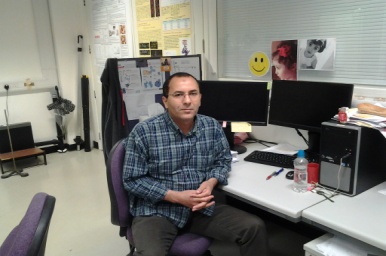Scientific Program
Keynote Session:
Title: Effect of Temperature on Molar Volume of ZnO Wurtzite Phase Under Extended Pressure and Temperature a Molecular Dynamics Prediction
Biography:
Yahia CHERGUI has completed his PhD from Badji Mokhtar University in Annaba, Algeria. He is a teacher in Boumerdes University since 2012. He has published more than 7 papers in reputed journals and has been serving as a referee with condensed matter journal (IOP) and Energy journal (Elsevier).He passed 6 months in Cardiff University and Queen University for summer school.
Abstract:
The behavior of molar volume of ZnO wurtzite phase is investigated using parallel molecular dynamics and dl_poly_4 software in RAVEN supercomputer of Cardiff University (UK). In this work we study the effect of temperature on molar volume of ZnO wurtzite type in the range of 300-3000K and 0-200GPa of temperature and pressure respectively. We analyze the relationship between pressure and temperature on molar volume; our data are in agreement with available results, although no more work under the previous conditions of pressure and temperature. Our work is very important in medicine, pharmacy, and geophysics, which need confirmation in future.
Oral Session 1:
- Inorganic Chemistry
Chair
Yahia CHERGUI
Mokhtar University
Title: Development of Atropisomeric Azo-binaphthyl Polymers for Light-driven Molecular Switches
Biography:
Fathy Hassan has granted the Doctor of Science degree from Graduate School of Science and Engineering, Saitama University, Japan in March 2018. He previously worked as a Junior Research Associate at Emergent Bioengineering Materials Research Team, RIKEN CEMS, Japan. Now, he is working as an Assistant Professor of Physical Chemistry at Chemistry Department, Faculty of Science, Tanta University, Egypt. His research interest is development of advanced functional materials for photonic and electronic applications.
Abstract:
Light-driven atropisomeric polymers containing azobenzene moiety as a photorsponsive segment and binaphthyl as an axially chiral segment were designed and synthesized. The polymers were obtained by radical polymerization, and the number-average molecular weight and polydispersity were around 7,000 and 2.0, respectively. The chiral polymer exhibited the glass transition temperature over 75 oC with good thermal stability above 280 oC. Solution-processed amorphous films could be obtained by spin-coating or drop-casting technique. The films show good uniformity without grain boundary, which are advantageous for fabrication of the thin-film devices. The chiral polymers in the film showed trans-cis photoisomerization upon irradiation at 365 nm for 180 s. The ratio of the trans:cis isomers in the photostationary state was determined to be 60:40. After photo-irradiation of visible light at 436 nm, cis-trans backisomerization occurred clearly. cis-trans thermal backisomerization also took place at 25 oC with a half-life of 13 h. Photoisomerization of the chiral polymer gave rise to photo-induced change in optical rotation. Photochemical modulation of the optical rotation reached to 700 o, and these values were switched by alternating irradiation between 365 nm and 436 nm. Interestingly, the polymers show fluorescence properties, which is a unique behavior compare to simple azobenzene polymers. Normally, azobenzene compounds are non-fluorescent because of the nonradiative relaxation process of the azo-benzene group caused by the highly efficient trans-cis isomerization. In terms of molecular design, binaphthyl moiety act as fluorescent segment leading to the overall molecule become has fluorescent. Further, a photoswitchable fluorescence behavior was obtained; an increase in the fluorescence intensity after irradiation at 365 nm and recovery to the initial state after irradiation at 436 nm.Additionally, photo-control of molecular orientation of the polymer was explored in the film. After photoirradiation of linearly polarized light at 532 nm, change in refractive index was observed owing to anisotropic molecular orientation. Maximum change in a value of birefringence after irradiation was 6 x 10-3. These results suggested the chiral polymers are expected to be photoresponsive chiroptical materials for light-driven molecular devices.
Title: Novel Schiff-base ligands for the selective extraction and transport of transition and post-transition metal ions
Biography:
Abstract:
The synthesis of a new series of Schiff base ligands is reported. The ligands are fully characterized using 1H and 13C NMR, FT-IR, mass spectrometry and elemental analysis. The extraction and bulk liquid membrane transport abilities of the ligands were evaluated by monitoring the extraction and transport of the metal ions Co(II), Ni(II), Cu(II), Zn(II),Cd(II) and Pb(II) over a 24-hour period. Palmitic acid was included in the organic phase. All ligands showed extraction of Cu(II) and Pb(II) ions, with 2 ligands being more selective towards the extraction of Cu(II) whereas the other 2 ligands extracted more Pb(II). The extraction of Pb(II) is most likely due to a synergistic effect, since palmitic acid was added throughout the organic phase. In the transport studies, only Cu(II) ions were transported. pH-isotherms for both Cu(II) and Pb(II) were also carried out for all ligands. Interestingly Pb(II) is extracted better at lower pH’s compared to Cu(II) in two cases. This study shows how these salen-type ligands, when used together with palmitic acid, show transport selectivity for Cu(II), and in the extraction studies, extraction selectivity for Cu(II) and Pb(II). Crystal structures of Ligands L1 and L4 respectively and two Cu(II)-complexes with Ligands L2 and L4 were obtained. The free ligand L1 crystallizes in the C 2/c space group. The final R-factor was 6.2%. The free ligand crystal structure L4 shows a structure similar to that shown with L1 with a final R-factor of 6.1%. The O atoms in this particular structure are in tris conformation to each other. In the crystal structure of the Cu(II) complex with ligand L2, the space group was Pbca and the final R-factor was 8.6%. The Cu(II) complexes with L4 is a distorted tetrahedral arrangement to the hydroxyl and the azomethine group of an adjacent ligand molecule to form a metallocycle bridged by the linkers. A new crystal structure showing how Pb(II) is coordinated to the Cu(II) complexes of L4 is reported.




